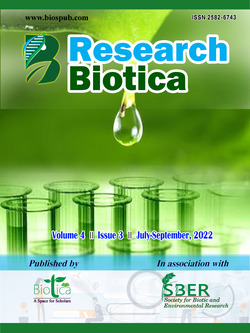
Plankton Composition in Relation to Physio-Chemical Parameters of Yamuna River at Three Different Cities of India
Sumit Kumar*
Dept. of Fisheries Resource Management, College of Fisheries, G.B. Pant University of Agriculture & Technology, Pantnagar, US Nagar, Uttarakhand (263 145), India
Amita Saxena
Dept. of Fisheries Resource Management, College of Fisheries, G.B. Pant University of Agriculture & Technology, Pantnagar, US Nagar, Uttarakhand (263 145), India
DOI: https://doi.org/10.54083/ResBio/4.3.2022/94-101
Keywords: Delhi, Phytoplankton, River, Yamuna, Zooplankton
Abstract
To evaluate plankton diversity in relation to physico-chemical parameters of the Yamuna river, the present study was conducted from March 2019 to February 2020. Three sites along the Yamuna River were chosen for regular sampling: Delhi (B1), Mathura (B2) and Agra (B3). 11 species of phytoplankton and 9 species of zooplankton were recorded from site B1 with a concentration of 15,517 individual L-1. At site B2 14 species of phytoplankton and 5 species of zooplankton with a concentration of 15,329 individual L-1 was observed. At site B3 a total 15 species of phytoplankton and 5 species of zooplankton were recorded with a concentration of 19,453 individual L-1. The highest abundance of group Cynophyceae in phytoplankton and Rotifera in zooplankton was observed during the study period at sites B1, B2 and B3. Physico-chemical parameters were found suitable for plankton growth at site B3.
Downloads
not found
Reference
APHA, 2012. Standard methods for the examination of the water and waste water. 22th Edition. (Eds.) Rice, E.W., Baird, R.B., Eaton, A.D. and Clesceri, L.S. American Public Health Association, American Water Works Association (AWWA) and Water Environment Federation (WEF), Washington, D.C., USA. p. 19.
Ariyadej, C., Tansakul, P., Tansakul, R., 2008. Variation of phytoplankton biomass as chlorophyll A in Banglang Reservoir, Yala Province. Songklanakarin Journal of Science & Technology 30(2), 159-166.
Asimiea, O.A., Sam-Wobo, S.O., 2011. The impact of hydrocarbon waste from brass oil terminal on the phytoplankton and periphyton communities of the Lower Brass River, Niger Delta, Nigeria. Journal of Emerging Trends in Engineering and Applied Sciences 2(5), 729-733.
Babita, S., Rao, S.N., 2015. A study on seasonal fluctuations in physico-chemical variables in spring fed Kosi River at Almora province from central Himalaya, India. International Journal of Current Microbiology and Applied Sciences 4(4), 418-425.
Badola, S.P., Singh, H.R., 1981. Hydrobiology of the river Alaknanda of the Garhwal Himalaya [India]. Indian Journal of Ecology 4, 24-36.
Bhatt, L.R., Lacoul, P., Lekhak, H.D., Jha, P.K., 1999. Physicochemical characteristics and phytoplankton of Taudha Lake Kathmandu. Pollution Research 18(14), 353-358.
Bhowmick, B.N., Singh, A.K., 1985. Phytoplankton population in relation to physico-chemical factors of river Ganga at Patna. Indian Journal of Ecology 12(2), 360-364.
Choudhury, A., 2001. Physicochemical characteristics in relation to pollution and phytoplankton production potential of a brackish water ecosystem of Sundarbans in West Bengal. Tropical Ecology 42(2), 199-205.
Dutta, S.P.S., Kour, H., Bali, J.P.S., Sharma, I.D., 2001. Hydrobiological studies on river Basantar, Samba, Jammu (Jammu and Kashmir). Journal of Aquatic Biology 16(1), 41-44.
Edmondson, W.T., 1959. Freshwater Biology. John Wiley and Sons Inc., New York. pp. 1248.
Giri, S., Singh, A.K., 2015. Human health risk assessment via drinking water pathway due to metal contamination in the groundwater of Subarnarekha River Basin, India. Environmental Monitoring and Assessment 187(3), 1-14.
Gorman, O.T., Karr, J.R., 1978. Habitat structure and stream fish communities. Ecology 59, 507-515.
Ingole, S.B., Naik, S.R., Kadam, G.A., 2010. Study of phytoplankton of fresh water reservoir at Majalgaon on Sindphana River District Beed (M.S.). International Research Journal 1(13), 87-88.
Jha, P., Barat, S., 2003. Hydrobiological study of Lake Mirik in Darjeeling Himalayas. Journal of Environmental Biology 24(3), 339-344.
Khanna, D.R., Ashraf, J., Chauhan, B., Bhutiani, R., 2005. Physico-chemical analysis of River Panvdhoi at Saharanpur (UP). Environment Conservation Journal 6(2), 89-94.
Khanna, D.R., Bhutiani, R., 2003. Limnological Status of Sati Kund Pond at Hardwar (UA). Indian Journal of Environmental Sciences 7(2), 131-136.
Khanna, D.R., Singh, R.K., 2000. Seasonal fluctuation in plankton of Suswariver at Raiwala (Dehradun). Environment Conservation Journal 1(2-3), 89-92.
Koshy, M., Nayar, T.V., 1999. Water quality aspects of River Pamba. Pollution Research 18(4), 501-510.
Kudari, V.A., Kadadevaru, G.G., Kanamadi, R.D., 2005. Zooplankton composition in some ponds of Haveri district, Karnataka. Zoo’s Print 20(12), 2094-2099.
Mane, V.R., Chandorkar, A.A., Kumar, R., 2005. Prevalence of pollution in surface and ground water sources in the rural areas of Satara Region. Asian Journal of Water, Environment and Pollution 2, 81-87.
Matthews, W.J., 1985. Distribution of Midwestern fishes on multivariate environmental gradients, with emphasis on Notropislutrensis. American Midland Naturalist 113, 225-237.
Meher, P.K., Sharma, P., Gautam, Y.P., Kumar, A., Mishra, K.P., 2015. Evaluation of water quality of Ganges River using water quality index tool. Environment Asia 8(1), 124-132.
Mishra, U.K., Yadav, V.K., 2020. Physico-chemical characters of Betwa River along Nautghat area, Bundelkhand region. BIOINFOLET-A Quarterly Journal of Life Sciences 17(4a), 542-547.
Needham, J.G., Needham, P.R., 1962. A Guide to the Study of Fresh Water Biology. Holden Day Inc. San-Francisco, USA. p. 108.
Neves, I.F., Rocha, O., Roch, K.F., Pinto, A.A., 2003. Zooplankton community structure of two marginal lakes of the River Cauba (Mato Grasso, Brazil) with analysis of rotifera and cladocera diversity. Brazilian Journal of Biology 63(3), 329-343.
Parashar, C., Dixit, S., Shrivastava, R., 2006. Seasonal variations in physico-chemical characteristics in upper Lake of Bhopal. Asian Journal of Experimental Sciences 20(2), 297-302.
Parashuram, R., Singh, A.K., 2007. Ganga Water Quality at Patna with reference to physico-chemical and bacteriological parameters. Journal of Environmental Science and Engineering 49(1), 28-32.
Pennak, R.W., 1978. Freshwater Invertebrates of United State, 2nd Edition. John Wiley & Sons, New York. p. 822.
Pramod, K., Pandey, A., Chandra, U.H., 2014. Seasonal variation in physico-chemical properties of Kali River in Pithoragarh District of Uttarakhand, India. Journal of Environmental Research and Development 8(3), 600-606.
Sharma, A., Sharma, R.C., Anthwal, A., 2007. Monitoring phytoplankton diversity in the hill stream Chandrabhaga of Garhwal Himalaya. Life Science Journal 4, 80-84.
Tonapi, T.G., 1980. Freshwater Water Animal of India: An Ecological Approach. Oxford and IBH Publication Co., New Delhi. p. 856.
